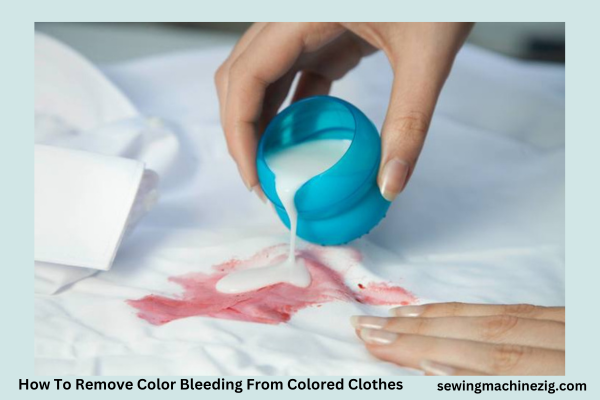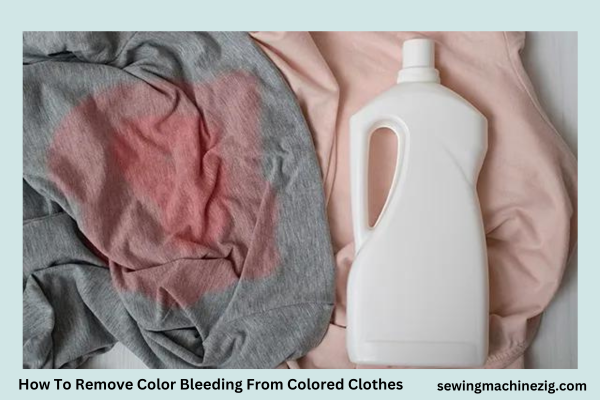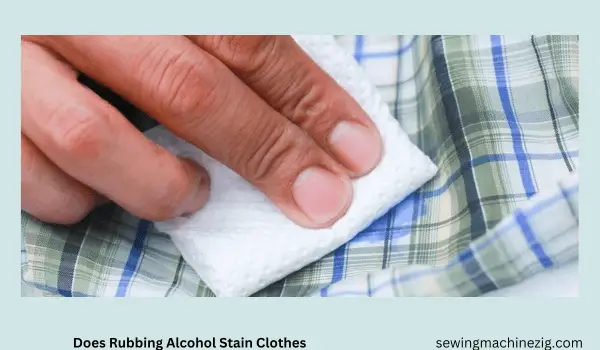
Color bleeding can be a frustrating issue when it comes to maintaining the vibrancy of your favorite colored clothes. Whether it’s a red sock turning your whites pink or a stray blue item dulling the brilliance of other garments, understanding how to remove color bleeding from colored clothes is essential. In this guide, we’ll explore effective methods and tips to help you salvage your wardrobe and keep your clothes looking as vibrant as the day you bought them.
How To Remove Color Bleeding From Colored Clothes Detailed Answer

Imagine this scenario: You’ve just finished your laundry, and the unthinkable unfolds before your eyes – your vibrant red shirt decides to transform your pristine whites into a delightful shade of pink. It’s the age-old conundrum of color bleeding, a situation that can disrupt even the smoothest of laundry days. But fear not, for we’re about to embark on a journey into the intricate world of stain removal. This voyage is filled with twists, turns, and more solutions than you can shake a washing machine at.
The Swift Intervention (or, Act Fast!)
In the grand saga of how to remove color bleeding from colored clothes, time is of the essence. The moment you catch those rebellious colors trying to stage a coup on your cherished attire, you must act swiftly to prevent the impending disaster. Procrastination and excuses are not an option.
In the epic battle to salvage your wardrobe, your first move is to segregate the troublemaker from the innocent bystanders. This is a crucial step to prevent further contamination. After all, you wouldn’t want your turquoise t-shirt to join the rebellion, would you?
The Fabric Chronicles (Know Thy Enemy)
In this battle, knowledge is power. The enemy you face is the rogue dye, and your trusty ally is the fabric label. Heed the label’s wisdom to navigate the treacherous waters of stain removal. Different fabrics require different strategies, and the care label is your blueprint for a tactical approach.
Cold Water: The First Splash (Cold Waters Run Deep)
Now, it’s time to immerse the troubled garment in a deluge of cold water, whether in a basin or under a running tap. Cold water is your ally in flushing out the rogue dye. Gently rub the fabric to aid in the liberation process.
Soap Opera (With a Twist)
If the villainous hues persist, it’s time to introduce a bit of drama with the soap opera. Mild dishwashing soap takes the stage as the star performer. Apply it judiciously to the stain and choreograph a gentle dance between the fabric and foam.
The Second Rinse (Cleanse & Repeat)
Following the soap treatment, rinse the afflicted garment thoroughly with that ever-so-cold water. A second rinse ensures you’ve cleansed away all traces of the enemy.
Spot Test Extravaganza (The Gamble)
When the dyes refuse to budge, it’s time to bring in the big guns – a color-safe stain remover. However, exercise caution, as the prudent approach is the wise one. Always perform a spot test in the hidden corners of your attire before launching a full-scale assault.
The Solo Washing Machine (Lone Ranger)
Should your stubborn adversary still flaunt its colors, it’s time for a solo wash. Follow the garment’s care label instructions, but stick to cold water. Hot water is the enemy; it can set the dye and lead to permanent defeat.
Post-War Inspection (Aftermath)
After the laundry battle, inspect your garment for any lingering stains. If your nemesis is still putting up a fight, avoid using heat to dry it. Instead, repeat the preceding steps until victory is yours.
A Vinegar-Infused Encore (For Stubborn Cases)
For those particularly stubborn dye insurgents, a white vinegar infusion may be your trump card. Soak the affected area in a blend of one part white vinegar to two parts cold water. After a 30-minute soak, rinse and return to the battleground, repeating the laundry process.
In the saga of how to remove color bleeding from colored clothes, victory is attainable with perseverance and a touch of laundry wizardry. Remember, the battle might be perplexing and riddled with unexpected challenges, but your colored clothes deserve nothing less than a triumphant return to their original, vibrant glory. It’s not just laundry; it’s an epic adventure.
How To Remove Color Bleeding From Colored Clothes Naturally
Dealing with color bleeding in your colored clothes can be quite a hassle, but the silver lining is that harsh chemicals aren’t always a necessity. Mother Nature offers ingenious solutions to tackle color bleeding from colored clothes naturally. Let’s delve into these eco-friendly remedies to ensure your wardrobe stays vibrant and free of toxins.
1. Vinegar Victory:
Nature’s Neutralizer When it comes to discovering how to remove color bleeding from colored clothes naturally, vinegar emerges as a trusty companion. Prepare a solution by combining one part white vinegar with three parts cold water. Submerge the affected garment in this mixture for a minimum of 30 minutes, allowing vinegar’s enchanting powers to set the dyes. Following the soak, rinse the garment with cold water to eliminate any residual vinegar. This technique often yields remarkable results without harming the environment or your attire.
2. Baking Soda Bliss:
Gentle on Fabrics, Tough on Stains Baking soda, renowned for its versatility as a natural cleaner, can also be your ally in battling color bleeding. Dissolve half a cup of baking soda in a spacious basin filled with cold water. Immerse the stained clothing and allow it to soak for at least an hour, if not longer. Baking soda’s remarkable properties come to the fore in extracting excess dye from your clothes. Following the soak, ensure the garment receives a thorough rinse, then proceed with your regular laundry routine.
3. Salt Solution:
Saline Savior Another kitchen staple, salt, proves to be invaluable in setting dyes and preventing further color bleeding. Fill a basin with cold water and add a generous quantity of salt. Allow the garment to soak in this saline solution for several hours, ideally overnight. This method aids in securing the color and putting an end to any ongoing bleeding. After the soak, provide the clothing with a gentle rinse and launder it as usual.
4. Lemon Freshness:
Natural Bleach Alternative Lemon juice, nature’s own bleach, comes to the rescue when dealing with color-bleeding stains. Saturate the stained area with lemon juice and allow it to bask in the sun for a few hours. The combination of lemon and sunlight serves as a natural bleaching agent. Subsequently, rinse the garment and proceed with your regular laundering process.
5. Cornstarch Revival:
Absorb and Renew Cornstarch exhibits surprising efficiency in absorbing excess dye from clothing. Create a thick paste by mixing cornstarch with cold water, then apply it to the stained area. Let it dry completely. The cornstarch will absorb the surplus dye. Brush off the dried paste and rinse the garment with cold water.
6. Natural Sunlight:
The Power of Solar Magic Sometimes, the uncomplicated act of hanging your clothes in direct sunlight can play a pivotal role in reducing color bleeding. The sun’s natural bleaching effect, coupled with the freshness of outdoor air, gradually lessens the intensity of stains. Regularly expose the stained area to sunlight until you achieve the desired results.
Are Color Bleed Stains Permanent?

Color bleed stains are not necessarily permanent, and their permanence depends on various factors, including the nature of the fabric, the type of dye, how quickly you address the issue, and the methods you use to treat the stain.
In many cases, color bleed stains can be successfully removed or at least lightened to the point where they are not noticeable. The key is to take immediate action when you notice the color bleeding, as fresh stains are typically easier to address.
Here are some factors to consider when dealing with color bleed stains:
- Fabric Type: Different fabrics react differently to dyes and stain removal methods. Natural fibers like cotton and linen often respond well to stain removal techniques, while synthetic fabrics may be more challenging to treat.
- Type of Dye: Some dyes are more prone to bleeding than others. For instance, red and dark-colored dyes are known to be more likely to bleed.
- Prompt Action: Acting quickly is essential. The sooner you address the stain, the better your chances of success.
- Stain Removal Techniques: There are various methods and products available for stain removal. Natural and eco-friendly options, like using vinegar, lemon juice, or baking soda, are often gentler on fabrics and the environment. However, for stubborn stains, commercial stain removers or even professional dry cleaning may be necessary.
- Test and Patience: Always perform a spot test on an inconspicuous part of the fabric before applying any stain remover to ensure it won’t cause further damage. Be patient and persistent in your stain removal efforts, as some stains may require multiple treatments.
In summary, color bleed stains are not inherently permanent, but their permanence depends on the specific circumstances. With the right approach and timely action, you can often successfully remove or minimize these stains, giving your clothing a chance to return to its original state.
Conclusion
Understanding how to remove color bleeding from colored clothes is an invaluable skill that allows you to salvage your wardrobe and reduce the frustration of unsightly stains. By employing natural remedies such as vinegar, baking soda, salt, lemon, and cornstarch, or even harnessing the power of sunlight, you can effectively address color bleed stains. These eco-friendly solutions offer not only a chance to restore the vibrancy of your clothing but also a sustainable and toxin-free approach to stain removal.
FAQS
1. How To Remove Color Bleeding From Colored Clothes Naturally?
Answer: To naturally remove color bleeding, you can use common household items like vinegar, baking soda, salt, and lemon juice. Soaking the stained garment in these solutions can often help eliminate unwanted color transfer.”How To Remove Color Bleeding From Colored Clothes“
2. Can I use bleach to remove color bleeding from colored clothes?
Answer: While bleach can be effective, it’s essential to use color-safe bleach to prevent further damage to your colored clothing. Always perform a spot test before applying any bleach.”How To Remove Color Bleeding From Colored Clothes”
3. What’s the best way to prevent color bleeding in the first place?
Answer: To prevent color bleeding, wash your colored clothes in cold water, sort garments by color, and use color-catching sheets or towels in the laundry load. Also, avoid overloading the washing machine.
4. How do I remove color bleeding from white clothes?
Answer: To remove color bleeding from white clothes, you can try soaking them in a mixture of hydrogen peroxide and water. Be cautious and perform a spot test as peroxide may affect certain fabrics.
5. What should I do if color bleeding occurs during a wash?
Answer: If color bleeding happens during a wash, stop the cycle immediately. Separate the affected item and follow the steps to remove the dye as soon as possible.
6. Are there commercial stain removers that work well for color bleeding stains?
Answer: Yes, some commercial stain removers are effective for color-bleeding stains. Look for products designed for color removal. Always read and follow the product’s instructions carefully.
7. Can I use cold water to remove color bleeding from colored clothes?
Answer: Yes, cold water is often the best choice for removing color bleeding. It helps to flush out excess dye without setting it. Follow it up with natural or commercial stain removal methods.



